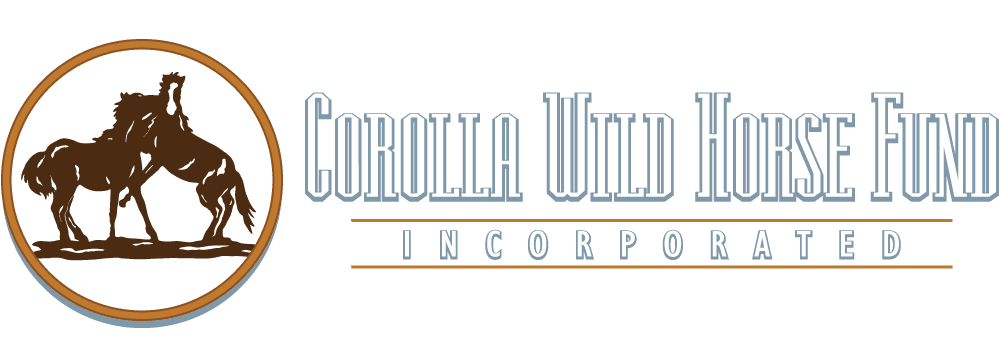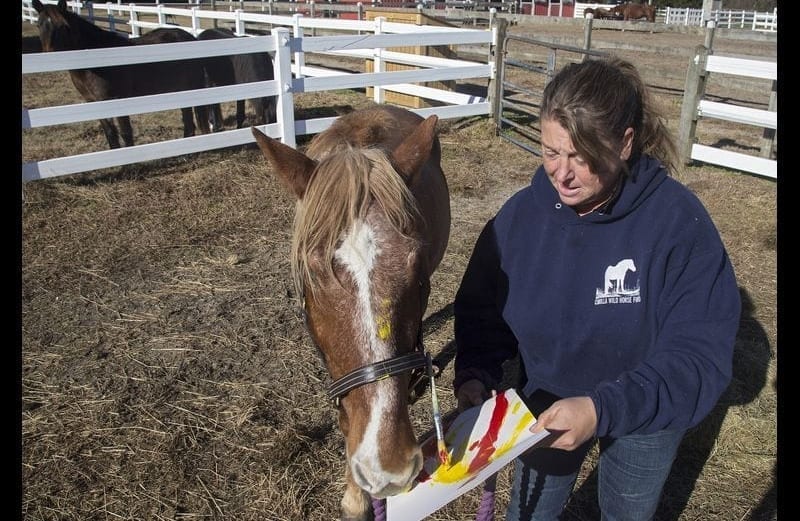Rescued wild horses create paintings
Horse trainer Nora Tarpley helps Amadeo, a 35-year-old blind Corolla wild mustang, paint on Monday, Nov. 25, 2019, at a farm in Grandy, NC. (Kaitlin McKeown / The Virginian-Pilot)
The brush tip dripped with red water-based paint.
Tarpley held an 8-inch-by-11-inch piece of white paper up to Amadeo’s nose. He hesitated a second, sensing the paper, before deliberately swiping the brush across the page.
“Oh, yeah,” Tarpley said. “Good boy.”
The Corolla Wild Horse Fund has started what zoos have been doing for years _ letting animals create artwork and selling the pieces to raise money.
For $30, the buyer gets a framed painting with a photo of the horse that created it.
Herd manager Meg Puckett helped elephants at the Virginia Zoo make paintings when she worked there years ago. That sparked the idea of getting wild horses to express themselves as well.
The artwork of a chimpanzee named Congo will be up for auction at a major London gallery in December. His works could sell from $1,800 to $7,400 each. In 2005, three pieces of Congo’s work sold for $25,000.
Congo painted in the 1950s while under the care of painter and zoologist Desmond Morris. The pair appeared on television and in newspaper articles in the late 1950s. Congo died in the 1960s.
A pig on a South African farm has become known as Pigcasso for his artwork for sale at an online site.
It is not certain if Amadeo has similar aspirations. He stood Monday in a scenic pasture of green grasses surrounded by white fences ready to complete his design. One swipe of red paint was not enough. This masterpiece needed something more.
Tarpley removed the brush, dipped it this time in yellow paint and reattached it to the leather halter, straps that wrap around the head used for controlling the horse. Amadeo touched the paper with his nose before making his stroke. The yellow and red brush marks across the paper blended into orange shapes in the center that looked like modern art genius to the casual observer.
“Is that not beautiful?” Tarpley said. “You did such a good job.”
Amadeo munched an apple slice from her hand as a reward and then got a scratch on his chest that made him stretch his neck high and put a smile on his big horse lips.
The paintings are done by horses removed from the Currituck Outer Banks and placed on a Grandy farm. The horses love the rewards that come afterward.
Like zoo animals, the painting activity is believed to be a welcome diversion from daily routine. Caretakers don’t make the horses create if they are not feeling it, Puckett said.
They give definite signals. Sometimes a horse will pull away from the offered brush. A female called Foxy Moxy usually likes painting, but on this day, she turned her rear end toward Tarpley.
All 15 horses at the farm have made paintings.
A gallery with a photo of each equine artist hangs in the visitor center of the farm. Each horse has a style and favorite colors to work with.
Raymond the mule has made one painting that has already sold at auction. Virginia Dare paints in dark blue with heavy brush strokes. Bella prefers lighter blues and covers the paper more comprehensively.
Amadeo loves reds and oranges. They fit his outgoing personality, Puckett said.
“He seems to be proud of it,” she said.



